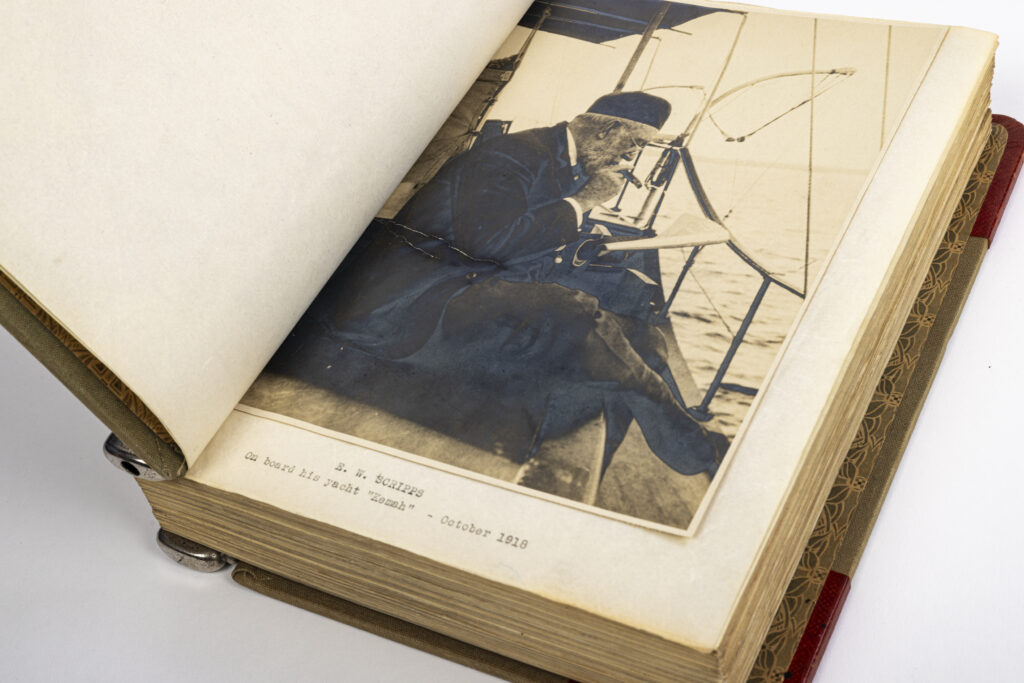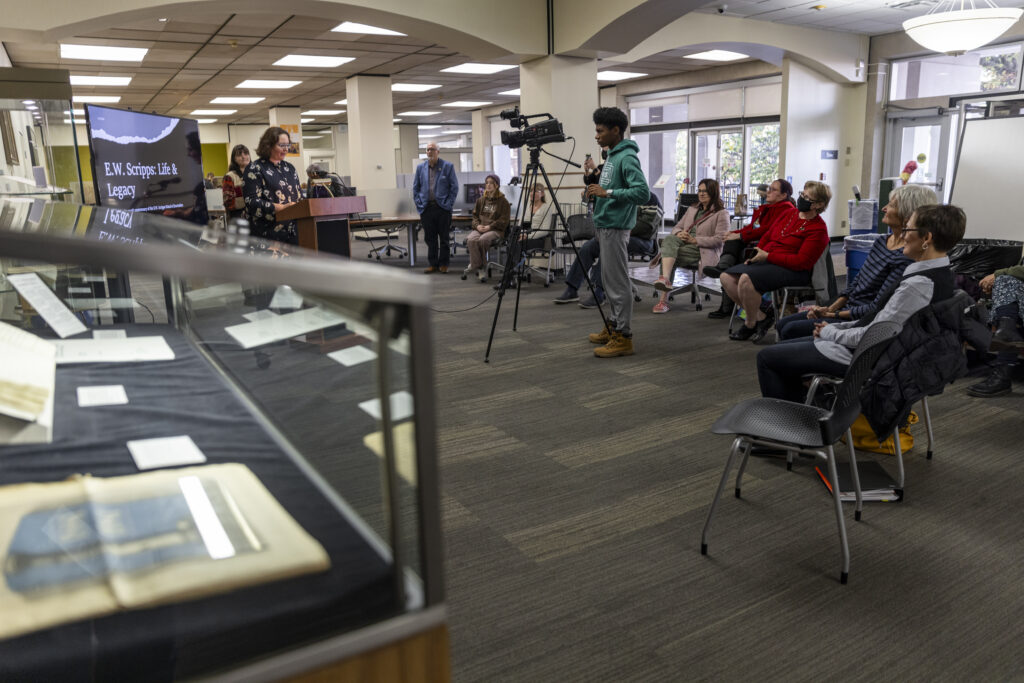By Alexandra Hopkins ’26, Journalism, Honors Tutorial College, 2023 Fall Mahn Center Intern
During Fall 2023, I had the opportunity to intern at the Mahn Center for Archives and Special Collections and work with my advisor, Greta Suiter. Our goal this semester was to curate an exhibit to celebrate the centennial anniversary of the E.W. Scripps School of Journalism.
At the heart of this endeavor was the E.W. Scripps Papers, a vast collection acquired by the university in 1988 from Charles E. Scripps, grandson of E.W. Scripps. As a student at the E.W. Scripps School of Journalism, I felt privileged to be able to work with this collection and contribute to the celebration of the school.

When I first began working with the materials, I was overwhelmed with the amount of stuff that I had at my fingertips. The collection itself is colossal, taking up 70 cubic feet in 187 boxes and possessing over 350,000 pages of letters written or received by Scripps. From the beginning I knew it would be impossible to go through every item with the time I had. Fortunately, someone had already used the collection to write about Scripps’ life.
Vance H. Trimble wrote a biography of Scripps’ life titled The Astonishing Mr. Scripps: The Turbulent Life of America’s Penny Press Lord, which served as my crucial guide. Trimble’s work aligns well with the Scripps collection. In fact, some of the items in the final exhibit were pulled directly from Trimble’s work, mainly saved materials or newspapers from the modern Scripps businesses.
After reading Trimbles work, I felt ready to sift through the collection. I began by identifying significant times in Scripps’ life, initially choosing to focus my research on 1914 to 1921. This was a time in which Scripps left retirement and re-entered the world of journalism, with a motivation to amend the lack of news from the nation’s capital during wartime. He felt he was obliged to the people, choosing to make headway in war correspondence by working directly from Washington, D.C.
Scripps’ feelings of obligation revealed itself as a common theme throughout his life, many times he chose to take on a project because he wanted to serve the public. This passion fueled his creation of the United Press Association, the ad-free Chicago Day Book, the Science Service, and numerous other endeavors.

I was unaware of how engrossed I would find myself in the life of Scripps. I became acquainted with his family life, working relationships, ideologies, stories, inventions, and so much more. He was a man of many layers and not always a good one, which became evident as I read through his various demands and the details of his rocky relationships. The exhibit itself was focused on his working life, but during the research process it was difficult not to immerse myself into every aspect of Scripps’ life to understand what should be included within the exhibit.
The exhibit’s name, “E.W. Scripps: Life & Legacy,” was chosen because this exhibit recounts the most significant moments in Scripps’ professional life as well as explores his impact on the journalistic world today. Interestingly, Scripps often thought about life after his death and the future of his businesses. In 1908, 18 years before his death, he wrote about his legacy:
The life history of a newspaper is almost identical with that of a man. All of its material attributes, its house, its material machinery of every description, may and almost invariably do change completely. More than this, the whole body of a newspaper may change by a complete change of the living persons. Such changes are usually a slow process of elimination and accretion, individuals going and individuals coming, and as the newspaper grows, it stands to reason that the growth is attended by the same phenomena as that of a child, namely, that the particles or the individual elements that are eliminated are fewer in number than those that are assembled to take their place. But through all of this dissolving and renewing personnel of a newspaper’s staff, there flows a spirit and the mind, the individuality, of the founder, most palpable and evident in its presence. Added to this individuality is that of other men: dozens, scores, hundreds and perhaps thousands who have at different times been present with and contributing to the life and growth of the newspaper organization. The founder of a newspaper, growing continually a less and less proportionate part of the whole staff, gradually as an individual sinks into insignificance, but since the founder selected and trained those who overwhelm him finally, he really exists in them. In this way, through the life and character of the founder of a newspaper, he will live perhaps for a much longer time than the term of his own material life, or at least for a much longer time than his own actual ownership and control.
– E.W. Scripps Papers, MSS117, series 4, box 1, book 1, Mahn Center for Archives and Special Collections, Ohio University Libraries
In the weeks before the exhibit opening, it was a flurry of work. Work that included writing labels, putting items into their display cases, fixing layouts, adding last-minute items, writing a speech and creating a presentation for the opening.


The exhibit opening went very well, thanks to help from various people at the library and in the archives. Despite the stress of the process, it was very fulfilling to see all our work come together and see people outside of the archives express interest in the exhibit.
My experience at the Mahn Center has been incredibly rewarding. I’m glad that I was able to contribute not only to the centennial celebration of the journalism school, but also to the work being done at the Mahn Center.
Watch the exhibit opening & explore the collection: